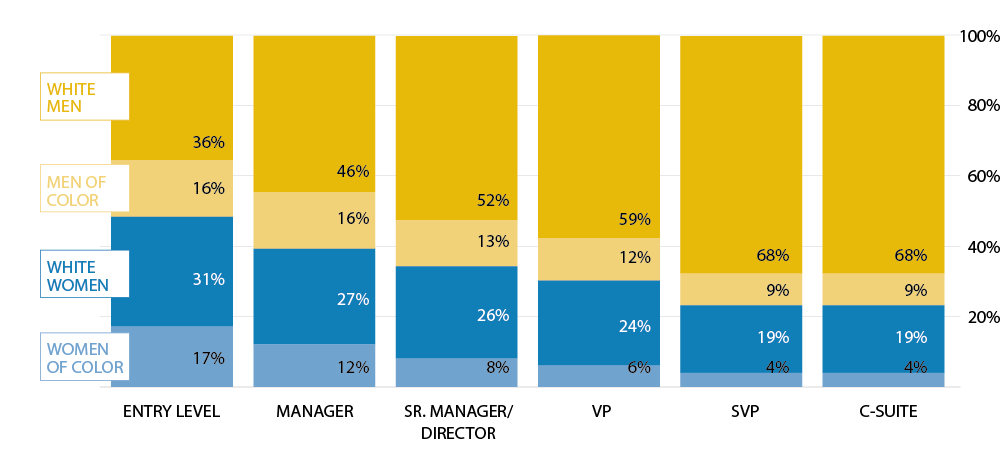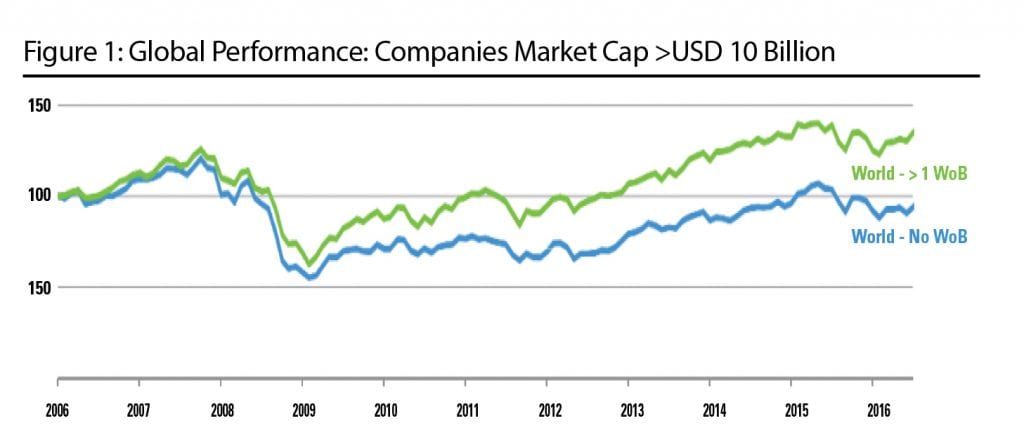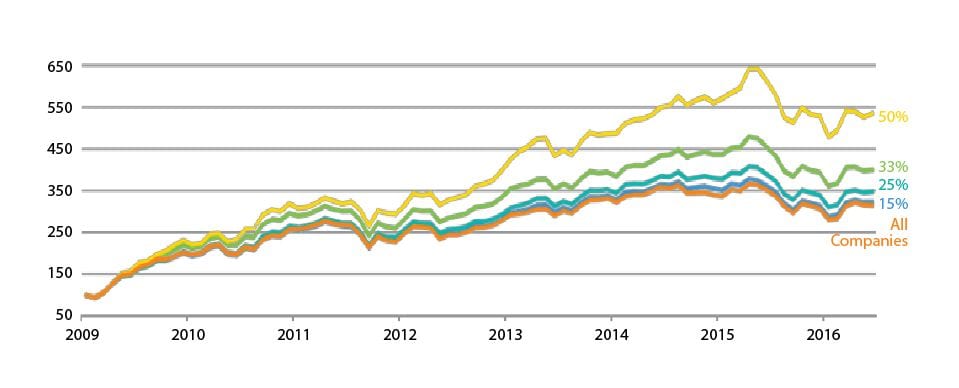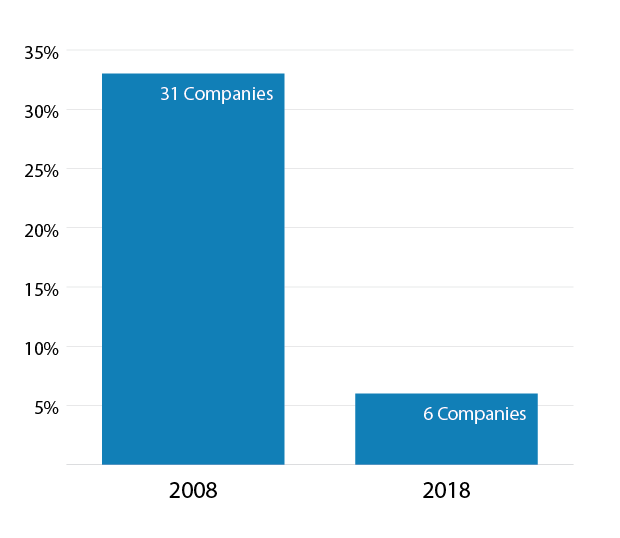Nicola Daniel
Executive Director, CFA Society Baltimore
In 2018 CFA Society Baltimore hosted our first conference, CFA Society Baltimore Alpha and Gender Diversity 2018. Our theme was chosen to reflect an increased focus in many asset management firms on mentoring young professional women up the ranks and on retaining them as they enter mid-career. At the conference, former presidential candidate and CEO of Hewlett Packard Carly Fiorina delivered a nuanced keynote address discussing her career trajectory and the challenges she encountered on her path to the C-suite.
Women have made enormous strides in the work place over the past three decades. Moreover, empirical data shows that the entrance of women into management has had a significant positive on the bottom line of firms. This BBR article outlines their impact. We also review the current the status of women in boardrooms and senior management in the US and Maryland, pointing out the barriers women still experience in career-building.
Women in Management Boost the Bottom Line
The positive impact of women on corporate profitability is now well-established by many studies done in the private sector and academia. While correlation does not establish causality, as our time series grows longer, the more data we will have to validate the strongly positive marginal impact.
The results from a 2016 study by Credit Suisse Research Institute (CSRI), “The CS Gender 3000: Reward for Change,” are particularly interesting.¹ Among other aspects, this study looks at the stock performance of companies with at least one woman on the board over 10 years. CSRI found that larger firms have more deeply developed diversity programs overall, so the dramatic outperformance is usually seen at companies this size or larger. Among firms with a market capitalization greater than US$10 bn, stock prices of firms with more than one woman on the board considerably outperform firms with no woman on the board (See Figure 1).
Figure 1: Global Performance: Companies Market Cap >USD 10 Billion
Importantly, they also find that the higher the percentage of women in top management, the greater the excess returns for shareholders. This is true both for their share price performance as well as hard metrics of financial performance (See Table 1). They note that companies in the “50% Club,” in which women represent at least 50% of the management positions, show particularly strong outperformance.
Table 1: Comparative returns for women in senior management
| ROE (%) | Net debt/equity (%) | Price/book (x) | Payout ratio (%) | |
| CEO | ||||
| -Male | 12.8 | 1.39 | 1.84 | 43 |
| -Female | 15.2 | 1.34 | 2.18 | 46.9 |
| Premium | 19% | -4% | 19% | 9% |
| Senior Management | ||||
| -Women <10% | 13 | 1.35 | 2.03 | 47.7 |
| -Women >15% | 15.3 | 1.21 | 2.09 | 41.7 |
| Premium | 18% | -10% | 3% | -13% |
| Source: CRSI 2016, pg. 25 | ||||
Figure 2: Share Price for Baskets with Different Tiers of Female Participation in Senior Management
A separate study from MCSI, “Women on Boards: Global Diversity in Gender on Corporate Boards”² supports the CSRI research. The MSCI report finds that:
- Companies with strong female leadership generated a return on equity of 10.1% per year versus 7.4% for those without (on an equal-weighted basis).
- Companies lacking board diversity tend to suffer more governance-related controversies than average.
- Strong evidence was not found that having more women in board positions indicates greater risk aversion.
Global Boardrooms
The reality of women in the workplace suggests that the empirical benefits of gender diversity is still not widely known or appreciated. MSCI’s report shows the state of women on boards.
Table 2: MSCI Status of Women on Boards 2015
| MSCI World Index % Women | 18.2% |
| MSCI USA Index % Women | 19.1% |
| MSCI Emerging MArkets Index % Women | 17.9% |
| Companies with One Woman Director | 73.5% |
| Companies with 3 or More Women Directors | 20.1% |
If the 50% Club is the correct benchmark for outperformance, it would appear that there is a significant opportunity for companies to attain such outperformance by closing the gender gap. Around the globe, Europe has led the way in bringing women to boards. The specific driver of boardroom numbers in Europe has been the introduction of quotas and targets in recent years, so that the average representation of women in the boardroom in the region stood at 24.4% at year-end 2015, an 80% increase over the previous six years, according to the CSRI study.³
The largest increase of women on boards was in Norway, where women comprised 46.7% of board members in 2016 an increase from 36.6% in 2010. In that year, legislation was introduced requiring that each gender must be represented by at least 40% of publicly-traded company boards. The improvement in Europe overall is a unique achievement, though the pattern of improvement holds across the globe.
Board Talent Pipeline
Although having women in the boardroom sends an important message to all stakeholders, outperformance is also inextricably linked to having women in the ranks of senior management. A key obstacle to bringing women on boards has historically been the lack of a talent pipeline. The CSRI study of 27,000 CEOs and senior management globally in 2016 found that the pipeline of women remains relatively weak despite great strides especially in the past two decades.
Table 3: CSRI Global Study of 27,000 CEOs and senior management⁴
| Women in Management, globally | 13.8% |
| Women in Management, USA | 16% |
| Women CEOs, globally | 3.9% |
| Women CFOs, globally | 14.1% |
| Women CFOS, China | 22% |
| Women in Business Unite Heads, globally | 9.9% |
At the level of business unit heads, the CSRI study shows that women now make up 9.9% of key senior positions that typically involve P&L responsibility for specific functions or geographic areas and which entail a considerable range of management and commercial skills. Compared to the 8.5% of business unit heads in 2014, this is a hopeful sign of progress.
Women on Executive Committees
A study by Oliver Wyman consultants looks at the senior management question from the perspective of Executive Committees (ExCos) in the US financial services sector.⁵ Wyman suggests that building the pipeline depends more on getting women onto ExCos than on boards, because ExCo members are more visible—both internally and externally—than Board members. Their competence and visibility make them more effective as role models and sponsors.
Wyman’s report shows that in 2003 women on boards and on ExCos were roughly equal. In 2016, the number of women on board grew by 8 percentage points to 20% globally, but women on ExCos grew only 5 percentage points to 16%. The authors attribute this difference to the policies mandating female inclusion on board that was not carried down to the ExCo level.
The Early- & Mid-Career Barriers
What has prevented the development of a more robust pipeline of women in senior management? The studies by Credit Suisse Research Institute and Oliver Wyman both show that the mid-career is the moment at which women face barriers that often stunt their career development.
Oliver Wyman and CSRI both document considerable efforts to increase the number of women in senior roles. Yet many companies seem to be stuck in the mud. In the financial services sector, Wyman attributes this to several factors, including:
- insufficiently flexible working options or stigma associated with using them;
- insufficient support for family responsibilities, for both men and women;
- lack of transparency in the promotion process and equal pay;
- lack of internal sponsorship, and;
- persistent unconscious bias.
In addition, Wyman points out that because many women receive lower pay (and often significantly lower bonuses), they are more likely to perceive the cost/benefits of a career differently than men. While the financial and personal cost of outsourcing child care falls disproportionately on women, it is the pay gap that cements the incentive for women to sacrifice their careers when they do so. In addition, structural constructs, such as maternity leave that is not matched by equal paternity leave, also tip the balance toward female attrition from the work place. While many Maryland institutions have now initiated paid paternity as well as maternity leave, the numbers are relatively small.
McKinsey’s “Women in the Workplace 2018” study of all US corporate sectors shows that young women encounter greater barriers not only at the mid-career level, but that they enter the job market on disadvantaged footing relative to their male counterparts.⁶ Although women graduate from college at a far higher rate, they represent 48% of the new hires relative to the 52% male entry-level hires.
Figure 3: Representation in the Corporate Pipeline by Gender and Race

Moreover, this gap widens early in the career life cycle. At the first critical step up from entry-level to manager, two men are promoted for every one woman to the manager level. In other words, women start their careers with weaker initial conditions than their male counterparts, and this gap further widens in the early stages. The table above from the McKinsey report demonstrates the early attrition.
Lack of interest in promotion cannot explain the gender gap. In fact, women are just as ambitious about promotions as men are. The 2017 McKinsey survey shows that US women in aggregate negotiate for promotions and salary increases nearly as often as men do — but clearly with differing outcomes.⁷ Wyman’s study validates this assessment.⁸ In their survey, 58% of women and 59% of men “stated a desire or strong desire to reach a senior position in their organization.”
McKinsey’s 2017 study pinpoints another surprising result. It is a considerably persistent belief that women often choose to leave the workforce due to family obligations. For the fourth year in a row, their study shows that “women and men leave their companies at similar rates, and they have similar intentions to remain in the workforce… Among those who intend to leave, 81 percent say they plan to stay in the workforce… Very few women and men say they intend to leave to focus on the family.” Only 1-2% of employees explicitly say they are leaving to focus on the family.
The McKinsey research validates what was also found in the Wyman study. According to the Wyman study, the US market is among those that are “getting there” in terms of their ability to attract and keep women in the workforce. They observe that the US has done all the right things to address the “visible” aspects of gender inequality.
The “invisible” aspects of gender inequality are the next frontier in advancing women in the US. The Wyman report summarizes the tougher issues that remain unresolved in table 4. These are major contributors to the intractable, “stuck-in-the-mud” quality of gender diversity efforts in many organizations.
“I have to adapt to the style and preferences of men. It is subtle but always there at the back of my mind everyday… gender is always there. Men never have to think about it – this is an advantage for them”
Table 4: Executive and Millennial Perspectives on What has not Changed
| What Has Not Changed | Executive Perspective | Millennial Perspective |
| The issues are subtle and invisible | “The first step is helping people understand that there is a problem” | “I have to adapt to the style and preferences of men. It is subtle but always there at the back of my mind everyday |
| Men and women are subject to different standards | “Organizations focus so much on women’s weaknesses. They are far more critical of women than men” |
“If a woman raises her voice it’s seen as complaining, but when a man does the same, he is making a point, he is being assertive” “All of the women at the top are extraordinary. Some of the men at the top are extraordinary, but all of the women are” |
| Women don’t get enough stretch opportunities | “Firms are more willing to take risks on men. With a woman, she has to prove it first – and because of that, women have less confidence. Men are also likely to take credit when they do not deserve it” | “I see it time and time again where competent women are passed over and a man is promoted instead” |
| Think successful, think men |
“When I first started, you had to act like a guy or you did not stand a chance” | “High performers are associated with masculine character traits, so we end up having to ‘masculinize’ our female traits” |
| Networking and bonding are critical – but harder for women | “Women tend to focus on execution – on getting their tasks done. But networking is what gets you the opportunities and enables you to succeed. You have to find ways and time to connect with the senior men” |
“Women are given more formal programs but fewer informal opportunities. We are not part of the conversation, of the network” “We are not in the ‘club’. The guys are already, naturally in the club” |
| Too many women remain silent |
“I spent most of my career thinking that if I do a good job, I will be recognized. It took me a long time to realize I needed to do more than that” | “You have to ask for the promotion, for the raise, for what you want. But you have to do so carefully. Otherwise, you get told you are too demanding or pushy. Or making trouble. The potential blowback on women for asking for what they want is much bigger than for men” |
| Traditional gender roles and assumptions are still there |
“There has been and still is a lot of social pressure for both men and women to fulfill traditional gender roles” |
“Many men of our generation still assume their career will take precedence over their wife’s career” “When a woman gets married the assumption is that she is less committed to the job because now she has a husband to support her” |
| There is a lack of role models at the top |
“Only when you have someone who looks like you do you internalize that you can make it too” “We set targets for everything in business that is important. So if we value having more women at the top, then we should set targets” |
“Women beget women. We need more women at the top – otherwise it will never change” “Each time a senior woman leaves or gets fired – it’s not just about the loss of her. It also crushes the hopes and dreams of all junior women who have so few role models” “I feel alone, isolated. There are so few women we can look to and see that they have made it. Makes you wonder if you can make it” |
| Source: Women in the Financial Services, Oliver Wyman 2016, pg. 35. | ||
Women in Maryland
We close by looking at the status of female representation at executive levels in Maryland, drawing on the work of the Executive Alliance. For the past 10 years, the group has been measuring the representation of women in the boardroom of public companies headquartered in Maryland. Executive Alliance is a non-profit professional organization whose mission is to accelerate the success and leadership of accomplished women by expanding their impact and influence through advocacy, education and mentorship.
According to their 2018 Census,⁹ women now hold 15% of the board seats in Maryland, an improvement from 9% in 2008. Maryland lags the national average of 22.2% for Fortune 500 companies. Twenty companies in Maryland still have no women board directors.
Figure 4: Percentage of Maryland Companies with No Women in Boardroom or Executive Suite
Figure 5: Percentage of Maryland Companies with Women on the Board or Executive Officers

Encouragingly, the number of companies where women held 20% or more of board seats doubled over the past 10 years to 26 from 13. In addition, the number of women executives increased to 63 in 2018 from 51 in 2008. Of those, 7 women are CEOs from a total 75.
Companies with NO Gender Diversity Improved Greatly
The number of Maryland companies with no women in either the boardroom or the executive suite declined from 31 in 2008 to six in 2018. Five of the six companies in 2018 that did not have women in either the boardroom or the executive suite were not part of the Census in 2008. They are all newer companies and concentrated in STEM industries.
References
- “The CS Gender 3000: the Reward for Change,” Credit Suisse Research Institute, 2016, found at https://www.credit-suisse.com/corporate/en/research/research-institute/publications.html
- “Women on Boards: Global Diversity in Gender on Corporate Boards,” MSCI Research Inc, November 2015, as referenced by CFA Institute, https://blogs.cfainstitute.org/marketintegrity/2016/10/07/the-current-status-of-women-on-boards-in-2016-a-global-roundup/
- “The CS Gender 3000: the Reward for Change,” Credit Suisse Research Institute, 2016.
- There is a cultural element to this in China, where finance is considered a stable profession for women. Indeed, the finance major is often more popular at Chinese universities among women than men by a large margin.
- “Women in Financial Services,” Oliver Wyman, 2016.
- “Women in the Workplace 2018,” McKinsey& Company and LeanIn.org, 2018. https://womenintheworkplace.com/
- McKinsey, “Women in the Workplace 2017,” pg. 8, https://womenintheworkplace.com/
- “Women in Financial Services,” Oliver Wyman, 2016, pg. 16.
- “2018 Census Report: Women Board Directors in Maryland,” Executive Alliance, 2018, https://www.executivealliance.org/census-report.




